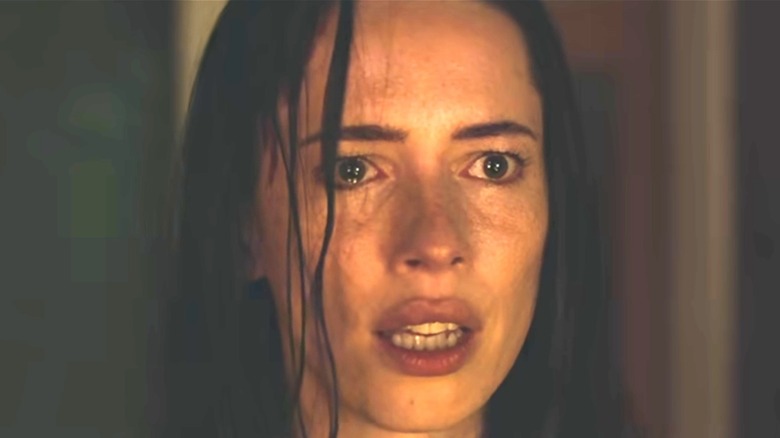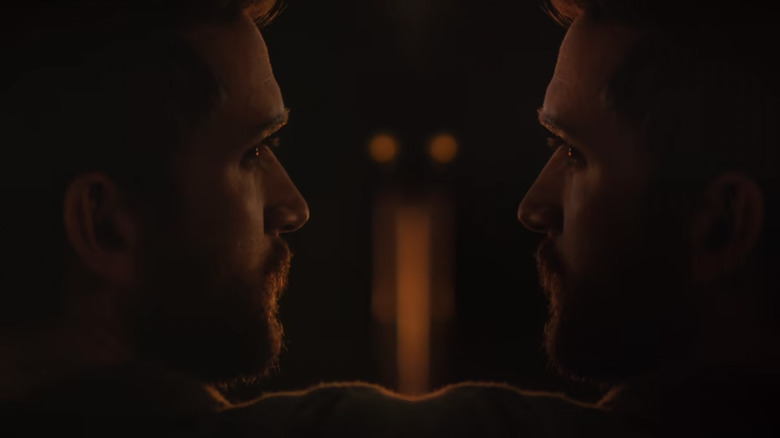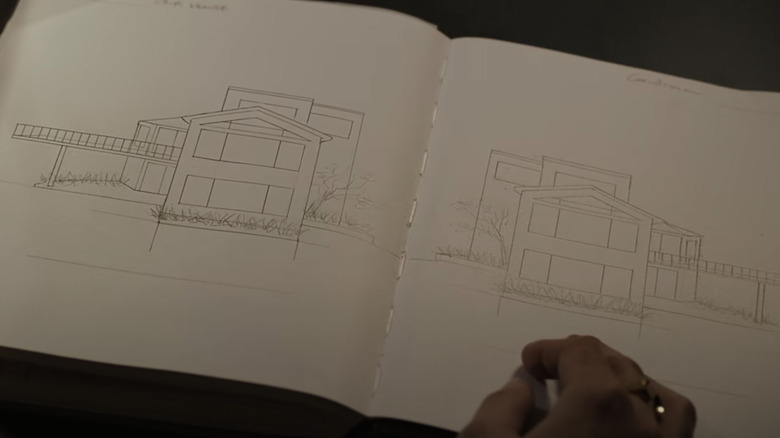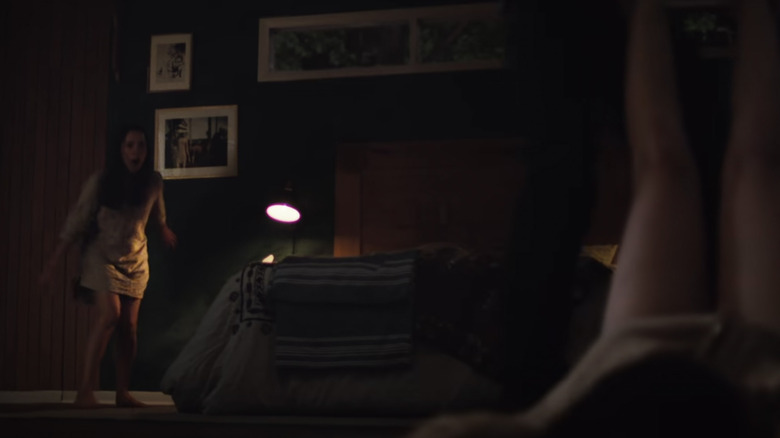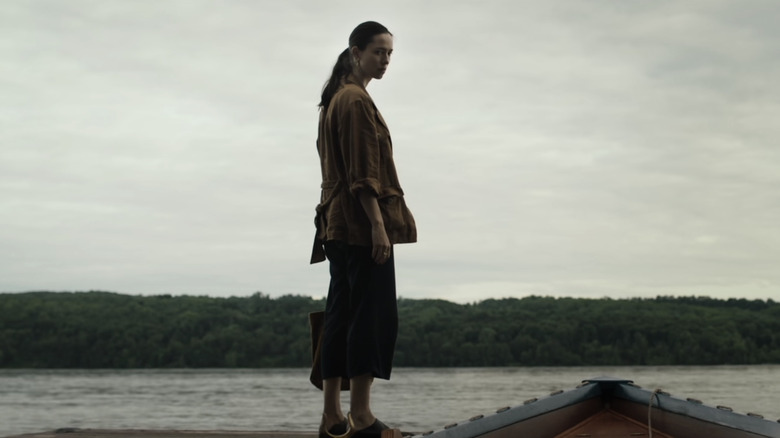The Ending Of The Night House Explained
David Bruckner's 2020 psychological horror-thriller film "The Night House" is quite unlike any other movie of its kind. Bruckner is a brilliant master of his craft and is known for directing other terror-inducing movies such as "The Ritual" (2017), "Southbound" (2015), and "V/H/S" (2012). Bruckner's latest project is the "Hellraiser" reboot, based on the disturbing 1987 film written and directed by Clive Barker. With a tightly structured screenplay written by Ben Collins and Luke Piotrowski, the film presents a smart, fierce, and unrelenting female lead, Beth (Rebecca Hall), who will stop at nothing to uncover the real truth about the husband she thought she knew.
The story follows the grieving Beth, a recently widowed woman who lives in a lake house built by her deceased architect husband, Owen (Evan Jonigkeit). Beth begins to suspect that there's a supernatural presence lingering in the home that she believes to be Owen, leading her down a dark path of perturbing and surprising secrets.
Boasting a well-deserved certified fresh 87% Rotten Tomatoes score, the film was highly favored among critics. Despite a terrific performance from Hall and Bruckner's stylish and stunning direction, "The Night House" had components that were confusing and an ending that could leave viewers feeling conflicted, which is why we're here to explain everything.
Owen is communicating with Beth from a parallel realm
It's revealed early on in the film that Owen took his own life for reasons which become clearer as the story progresses. Beth deals with this tremendous grief and loss primarily by drinking, and living alone in a huge lakeside house in the forest doesn't help her ailing mental state. She thinks she may be going crazy – constantly hearing noises in the house. One night, the stereo downstairs randomly begins playing her and Owen's wedding song loud enough to wake her out of the deepest sleep.
One morning Beth steps outside to the dock, only to see muddied bloody footprints that appear to be somebody emerging out of the water close to where Owen died. Still reeling from the shock of his absence, she doesn't quite know what to believe. Ghostly visitations begin to occur frequently and Beth can feel that it's Owen trying to communicate with her in various ways. Further delving down a rabbit hole, Beth receives a strange text from Owen in the middle of the night telling her to come down the stairs. Panicking, Beth calls Owen's phone only to hear static noises and, then, an indistinct male voice says her name. This ominous voice prompts Beth to look out the window, and there's a naked Owen standing on the surface of the lake, turning around to stare at her.
Waking up gasping, Beth finds herself lying in a spot that's not her bed. Ever since Owen passed, Beth has been sleepwalking — a condition she acknowledges that Owen always experienced but never her. It gets even creepier ...
Their house is a reverse layout of another house
In an attempt to try and move on, Beth starts gathering Owen's belongings and throwing them away. While she is in his office, she finds a sketchbook that was her gift to Owen for him to draw his sketches and floor plans for their home. As she flips through the pages, she discovers some strange drawings marked with language such as "confusing patterns" and "trick it, don't listen to it." The word "Caerdroia" is at the top of one of the pages, with an illustration of one house and an identical house on the next page, labeled "our house" and "reverse floor plan." Thinking it's probably insignificant, she shuts the book and puts it away.
Much later, while Beth is taking a walk through the woods, she encounters their property caretaker, Mel (Vondie Curtis-Hall), and he affirms that there are no other houses built nearby. As she keeps walking, she encounters a decrepit, abandoned house camouflaged in the forest's thickness. As Beth makes her way inside and then up to the second story, she sees a bucket in the center of the floor. She notices a strange stone figure of a female with various sticks poked all over its body, similar to what she found in Owen's sketchbook existing at the center of the mirrored house floor plan.
Beth goes back to Owen's office and discovers a book titled "Caerdroia." The Caerdroia hails back to Celtic heritage, and it consists of perplexing mazes and backward patterns as a means of tricking dark forces or spirits. The pages contain scribbles in Owen's handwriting and a photo of the same female statue that she discovered in the reverse house. Called a "Louvre doll" or "voodoo doll," the figure was used as part of Owen's hidden plan for deceiving the insidious spirit of nothingness.
Owen turns out to be a serial killer
Aside from the reverse house twist, the other big surprise revealed was that Owen was killing other women who looked like Beth. In order to trick the Nothing that was alluded to in his suicide note, Owen was carrying out the carnage for years. The reverse floor plan and the building of the mirror house were also Owen's plan of deceiving the Nothing by mostly burying all of the bodies under the other house, with some even buried in the house he and Beth shared. Owen's big scheme allowed Nothing to think that he was killing Beth when really, it was just women who were carbon copies of her. So, why does this nothingness want her so badly?
Well, a younger Beth escaped Death when she in a horrible car accident, and was actually announced as dead for several minutes, but eventually came back to life. Since then, Death/Nothing has been trying to get her back into its dark realm, and all Owen was trying to accomplish was to protect her from this evil force. Hence, he ended up getting rid of himself to appease the Nothing, but it still knew Beth was alive and she eventually uncovers its sole purpose — to get her to kill herself and join it on the other side.
An end that may not justify the means
During an intense and bloody battle between Beth, Owen's spirit, and Nothing, Beth eventually pulls herself out of the other realm. Nothing tries to convince her to take her own life so she can be with Owen and end her suffering. Meanwhile, death and life are mentally and physically pulling her in different directions, yet much to Nothing's surprise, she is able to snap out of the nightmarish dreaming state. When she discovers that she doesn't want to join Owen and Nothing, that turns out to be her greatest strength in defeating Death. She knows that she wants to live with or without Owen by her side. However, the ending is open for interpretation since it can be hinted at that Nothing's presence is still lingering and Beth may have to confront it at some other point in her life.
"The Night House" becomes an often terrifying and mystifying meditation on grief, guilt, death, and depression. The fascinating psychological component of the narrative and overall metaphorical message lies in the difficult choice that comes with all of that emotional turmoil after a loved one dies and how it's coped with on a daily basis.
If you or anyone you know is having suicidal thoughts, please call the National Suicide Prevention Lifeline at 1-800-273-TALK (8255).
